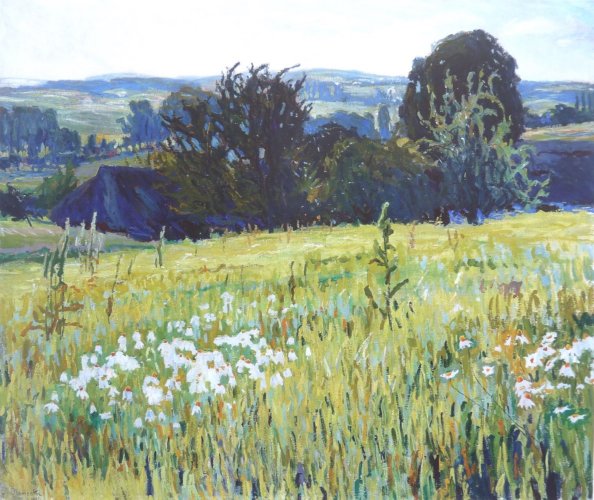Description:
Stanisław Kamocki (1875-1944). His father, an architect, gave him his first drawing lessons, then Kamocki studied at the SSP in Krakow, among others with L. Wyczółkowski, J. Malczewski and J. Stanisławski. He spent a large part of his education on a scholarship in Paris and travels in Italy. In 1908 he became a professor at the School of Fine Arts for Women, and from 1919 he headed the landscape department at the Krakow ASP. He was considered a continuator of J. Stanisławski. He devoted his artistic life to the landscape.
Description of the painting:
“Spring Wheat“ is one of the series of paintings created in the vicinity of Tyńce, depicting fields of various grains. Characteristic of this series is the frame almost reduced to a square and frog perspective. We can imagine the painter sitting among the swaying grass, swept by the wind and the smell of herbs.
Stanisław Kamocki was a student at the Krakow School of Fine Arts, where he was taught by Malczewski and Wyczółkowski, but it was Jan Stanisławski, a renowned landscape artist, who had the most influence on his creativity. Kamocki became the greatest and most important heir to Stanisławski‘s artistic legacy. His art was also shaped by a two–year stay in Paris, trips to Italy, visits to European art galleries and the studios of other artists, such as Ruszczyc and Chełmoński, but it is difficult today to separate his name from Stanisławski‘s. A few years after his master, Kamocki even took over the landscape chair at the Krakow Academy of Fine Arts.
Kamocki‘s favorite subjects were fields, grains, orchards, manors, rural churches, cottages, and vast landscapes. His landscapes are characterized by a wide range of colors, especially greens, but usually muted, harmonizing with the scattered light of a slightly cloudy day. An example of this is “Spring Oats“, where the sky is whitened, contrasting with the distant blues of the fields and harmonizing with the white flowers in the foreground. Aerial perspective emphasizes the space that stretches further than the eye can see. Kamocki uses a delicate synthesis, without leaving the real landscape. This gives him a decorative effect, especially visible in the section of oat stalks and the trees behind them. The fancifully painted and flat treated tree crowns may suggest the popular influence of Japanese art at the time, which is also visible in the painter‘s other compositions.
The muted colour palette and beauty of the sunless landscape breathes lyricism and melancholy, perhaps also arising from the lack of scenery. The artist invites us to a solitary hill, a place where, sitting among the grass, one can ponder, gazing out at the distant horizon.


